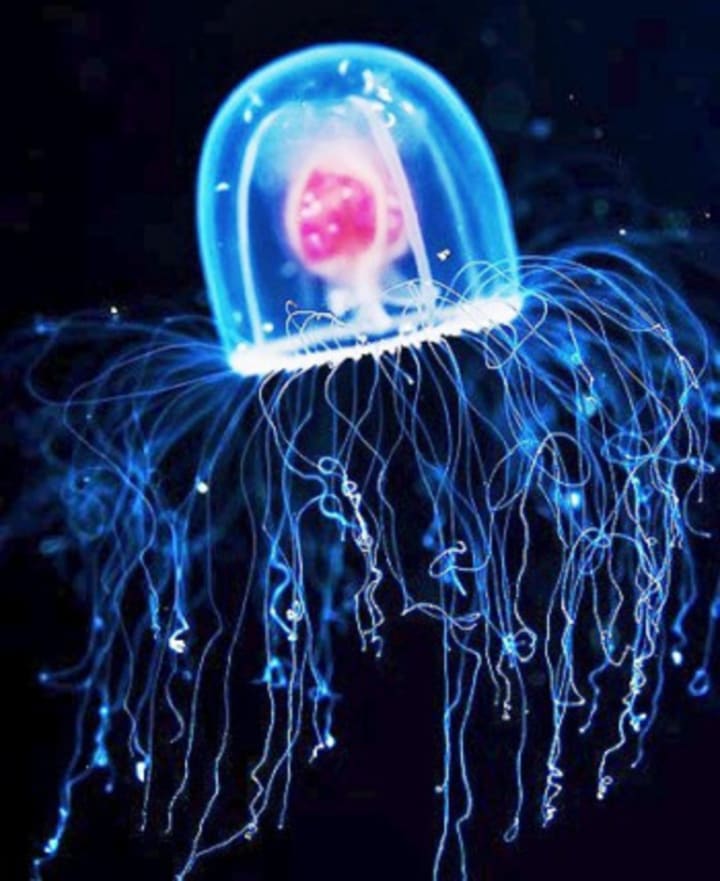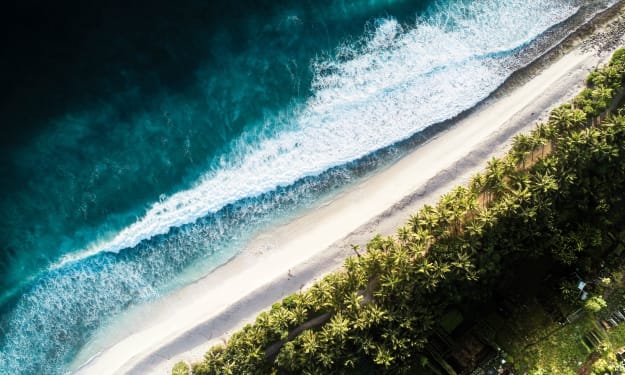Top 10 Oldest Living Creatures on Earth
Unbelievably, many long-living creatures consider 80 years to be just infancy! Let's look at a few of the planet's oldest living things.

What Is the Oldest Living Creature on Earth?
A person is deemed to be of suitable advanced age if they live to be 80 years old. But for many species that live a long time, 80 years is just a baby. Here are some of the planet's oldest living things, ranked from immortal to 120 years in life expectancy, in a top 10 list. The following creatures with extraordinary lifespans are covered in this article:
1. Immortal Jellyfish
2. Prehistoric Nematodes
3. 11,000-Year-Old Glass Sponge
4. 4,265-Year-Old Black Coral
5. 520-Year-Old Greenland Shark
6. 507-Year-Old Quahog Clam
7. 255-Year-Old Giant Tortoise
8. 226-Year-Old Koi Fish
9. 211-Year-Old Bowhead Whale
10. 120-Year-Old Tuatara
1. Immortal Jellyfish

What more fitting way to begin a list of excruciatingly old creatures than with a species that may be indestructible? One of the most unusual animals on the globe is without a doubt the Turritopsis dohrnii, also referred to as the "immortal jellyfish" or "immortal jellyfish" informally. It is the only one that, as far as we are aware, has the potential to live eternally, if not forever. This is accomplished by adhering to the counsel that many of us receive as we become older—they embrace their inner kid, yet
The jellyfish's body starts to shut down after reproduction. The jellyfish will actually go back to its juvenile polyp stage and grow into a mature jellyfish over time rather than letting death occur naturally. They can do this as many as they desire, and they will always be the same jellyfish. The jellyfish practically lives forever by continually growing up, down, up, down, and up again. According to our knowledge, an immortal jellyfish can only perish due to an accident, illness, or predator.
The jellyfish could theoretically outlive both our species and whatever dominant species come after us (or maybe they will become the dominant species), as long as nothing interferes with their self-contained cycle of life. However, if they remain healthy and don't end up as anyone's dinner, they could theoretically outlive both our species and whatever dominant species come after us.
2. Prehistoric Nematodes

Worms from the distant past have to be constructed of much tougher materials than modern worms. What other way is there to account for two worms that, after 42,000 years of cryogenic immobility, reanimated themselves as if by design? In July 2018, Princeton University and a group of Russian researchers collaborated to examine 300 samples of nematode roundworms that had been preserved in Siberian permafrost.
The scientists chose and defrosted worms from two top samples, expecting little more than good research to occur; nonetheless, they discovered a near-miracle. The worms had been frozen since the Stone Age. The worms started moving! Additionally, they began to eat! After all these centuries, they still appeared to be very much alive.
To confirm that these weren't typical, contemporaneous worms, the worms were rapidly carbon-dated, and sure enough, one worm was about 32,000 years old. The other worm was astoundingly only a little under 42,000 years old. They are the world's earliest multicellular living organisms as a result.
Since roundworms only live for around four months on average, it seems unlikely that these two worms are still alive. Unless, of course, the researchers were foresighted enough to refreeze them, in which case they may be rethawed and examined in 50,000 years!
3. 11,000-Year-Old Glass Sponge

A sponge can live forever? One particular glass sponge lasted far longer than humans will ever do, so it might as well have lived forever. In 2012, a member of the sponge species Monorhaphis chunni that had just been found in the East China Sea was reviewed in the appropriately named Ageing Research Reviews journal. A fast carbon dating experiment showed that the sponge had survived for an astonishing 11,000 years.
By examining this sponge's skeleton, scientists were able to learn new details about shifts in ocean temperature over the last 11,000 years. They think that the presence of manganese in the sponge's skeleton, which led to uneven development patterns, proves that it survived seamount eruptions.
Despite spending a large portion of its 11,000 years frozen, this sponge managed to live and develop continuously for 11 millennia. This is an unrealistic lifespan, even for a deep-sea organism with few actual predators. Since the one sponge in question shares the same traits and defense systems as every other member of its species, it is difficult to determine with certainty how it managed to survive for so long. It's possible that its size, which generally determines sponge longevity, is what caused it to endure so long.
Sponge sizes larger than one meter may live for several thousand years, however, microscopic sponges may only last a few years. This robust not-little guy was at least that wide and had spikes that reached a height of ten feet. Any theories as to how this specimen lived in the ocean for 11,000 years before departing for that enormous sponge rack in the sky are welcome.
4. 4,265-Year-Old Black Coral

The most fascinating animals on the earth are not corals. Even if they spend their entire lives in the same area of the ocean floor, it is nonetheless amazing to learn that at least one particular piece of coral has survived since the time of the Old Kingdom of Ancient Egypt. A group of Texas A&M researchers who had been investigating the black coral Leiopathes glaberrima off the coast of Hawaii had a change of heart in 2009. They have been sure that the coral is barely a few hundred years old since their research in 2002.
In fact, the specimens ranged in age from 2,000 to 4,265 years, which is equivalent to believing a girl is in preschool when in reality she is someone's 90-year-old grandma. Its age is made much cooler when you realize that it resembles an old Halloween creature in the form of a black skeleton with orange tissue.
It's not cool that human fishermen, whose nets harm the corals, are putting this 4,200-year-old creature in danger. Additionally, coral is constantly being stolen by poachers for jewelry. Hopefully, we can stop putting these timeless marvels in jeopardy soon and stop interfering with them, allowing them to live on in eternal splendor.
5. 520-Year-Old Greenland Shark
Living to 500 would probably be cool, as long as you don't become older physically and mentally each year. Unless, of course, during roughly 150 of those years you don't reach sexual maturity—in which case, it would definitely be less enjoyable. But here is a Greenland Shark's life—likely the longest-living shark species on the planet.
They don't begin to age for a very long period because they only gain about one centimeter each year. The average Greenland shark can live for 400 years, however, there are some sharks that are definitely outliers. One in particular, is a massive 5 meters (16 feet) long, making it the largest Greenland shark ever and possibly the longest-living shark in history.
This shark was estimated to be 392 years old by a 2016 study that was published in Science Magazine, with a plus/minus range of 120 years. Accordingly, this shark may be close to 520 years old and still going strong. However, as was already established, this longevity has a cost; female Greenland sharks are sterile until they are approximately 160 years old. So, while they wait to become old enough to have children, they basically swim around and eat.
So how did we establish the age of these sharks? oddly enough, using nuclear radiation's abilities! Due to radiation seeping into the water from nuclear bomb testing in the 1950s, they found numerous dead sharks with significant levels of carbon-14. The sharks' body lengths and the amount of carbon in their bodies indicated to the scientists that they were born in the 1960s.
Many additional Greenland sharks, including the one that may be 520 years old, had their approximate ages determined using this simple procedure (body length plus carbon-14 amount). Although there aren't many positive outcomes from nuclear weapons, understanding these sharks is undoubtedly one of them.
6. 507-Year-Old Quahog Clam

A clam could live for more than 500 years. However, when it was dredged up by a fisherman in Iceland in 2006, it probably wouldn't have been delicious to eat. The fisherman's discovery of a Quahog clam had a long history, which became immediately clear. After counting the lines on the shell, scientists came to the conclusion that the clan had existed for 405 years.
After a short while, a more accurate line count showed the truth: this clam lived for 507 years! As a result, it is the oldest living creature whose exact age has been established. The media gave the clam the name "Ming" in honor of the lengthy Ming Dynasty, which was in power when it was born, as befitted something so old. Some people prefer the Icelandic woman's name "Hafrn," which approximately translates to "the mystery of the ocean."
Nobody knows how the clam survived for so long, true to its name, as it couldn't possibly exercise in that shell. The fact that, nearly 15 years later, we are still unsure of Ming/Hafrn's gender and that, due to its advanced age, nothing more than the fact that its reproductive organs were no longer functional could be learned about the creature's gender further adds to the mystery. Your reproductive organs are officially categorized as spent, which is probably the last thing you want to hear.
Ming/Hafrn was tragically killed by humans when they froze it on board their ship.
7. 255-Year-Old Giant Tortoise
Rarely do giant tortoises struggle to live a lengthy life. As long as they are not eaten by a bird or a snake when they are tennis ball-sized babies, many of them live to be 100 or even 120 years old. This only serves to enhance how wonderful the tale of one ancient tortoise is. One Aldabra giant tortoise that was born around 1750 lived to be 255 years old before passing away in 2006!
The oldest living land animal in the world and arguably the longest-lived land animal ever was Adwaita, which means "one and only" in Sanskrit. He was indeed so old that in the 18th century, he was one of the tortoises owned by British General Clive of India! Incredibly, there isn't much in this tortoise's background that would indicate why he lived for so long; by all accounts, he was a typical tortoise, ate typical tortoise food, and led a typical tortoise existence.
But for some reason, he persisted longer than any other tortoise has ever. Truth be told, if not for one particular circumstance, he might still be alive today. In 2005, a fracture appeared in his shell, creating a wound that would soon become septic. Adwaita passed away a year later, and carbon dating of his shell determined that he had actually lived for 255 years. The jury is still not any closer to determining how he did it.
8. 226-Year-Old Koi Fish
Anyone who has had to dump a two-week-old goldfish down the toilet can attest to the short lifespan of the majority of fish. However, some fish live longer than others. For instance, Japanese koi fish can live up to 40 years. Hinako is another example of a koi that clung on for much longer than she had any right to. She was an amazing 226 years old when she passed away!
Hinako was born in approximately 1751, some decades before the United States. Before ending up in Dr. Kimiko Shihara's pond, she floated from owner to owner. The good doctor claimed that carp had been passed down to them by his grandmother's mother-in-law. When he realized this, he was curious about the age of the fish. To his complete surprise, the expert's study of two of Hanako's scales in 1966 revealed that she was 215 years old—more than twice as old as the oldest koi that anyone had ever heard of.
Hanako continued to live for another ten years before passing away on July 7, 1977. Dr. Shihara also had his other koi fish examined in an effort to comprehend how this could possibly have happened. When he noticed they were all between 139 and 168 years old, he hypothesized that their long lives were due to a mix of pure water isolation, peace, and just plain good fish genes.
9. 211-Year-Old Bowhead Whale
The typical lifespan of whales varies depending on the species; for example, blue whales can live up to 80 years whereas killer whales may only survive to 30. The bowhead whale, the oldest living whale in the world, is the next species. It may also be the oldest mammal era.
A bowhead shark with a harpoon lodged in its head was taken by a fisherman in 2007. Additionally, that specific brand of the harpoon was only made from 1879 to 1885. Curiosity prompted an additional examination of the specimen, which revealed that it had been dead for about 130 years. The whale would rank among the oldest mammals ever only based on that fact, but scientists were also interested in the species as a whole. The majority of the bowhead whales they examined were between 135 and 170 years old when they passed away, but one outlier lived to be 211 years old.
It was likely born around the time George Washington was president because it passed away in the 1990s. It's nearly unheard of for mammals to live that long, let alone fish and reptiles. According to experts, the reason bowheads live so long is that they only eat small amounts of food and only inhabit chilly northern waters. This led them to evolve the ability to constantly cover themselves in thick, warm coats of fat-storing blubber. This, combined with the cold water's effect of making the whales develop slowly and use less energy, results in an exceptionally long lifespan.
10. 120-Year-old-Tuatara

The uncommon New Zealand lizard known as the tuatara normally lives for about 60 years. Except for one strong tuatara who is pushing the boundaries of his species' morals and evolutionary age. Henry, a tuatara, has managed to live to 120 years old and is still going strong. Given that he had cancer—yes, his handlers found a cancerous tumor near his genitalia in 2002—it is all the more remarkable that he has survived this long.
Henry was so relieved when it was taken out that he chose to start a family at the age of 111. Not merely because of his age, Henry was not the fatherly type. When Henry's keepers wanted him to mate with a female named Mildred, he had been hostile and even bit her tail off. However, once the cancer was removed, Henry was a completely different lizard, and he and Mildred reconciled and had 11 children. If you look at how Henry is currently living with at least three lady Tuataras, you can tell he is still alive and healthy.
Max. Life Span
In studies on animals, the maximum life span is frequently assumed to equal the average lifespan of the 10% of subjects who lived the longest. However, according to a different definition, the maximum life expectancy is the age at which the oldest member of a species or experimental group has passed away. The initial sample size affects the calculation of the maximum life span in the latter sense.
The AnAge database contains information on the maximum life span of the majority of species.
For species that are larger or have strong defenses against predators, such as bird flight, chemical defense, or living in social groupings, the maximum life span is typically longer.
About the Creator
Ahamed Thousif
🌟 Welcome to the realm of exploration, where communities come alive through the power of words! 📚✨ Join me as we embark on a journey to discover the vibrant tapestry of stories and Poems.
VISIT - "MY FOOD BLOG"






Comments (2)
This is awesome! Going to read with my son, I know he'll love this!
Wow, I really enjoyed reading about all of these amazing creatures. Great article!